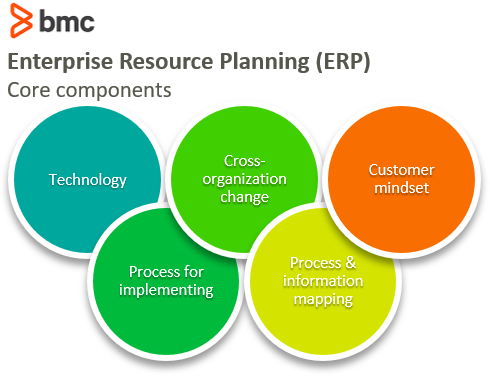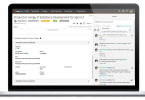Enterprise resource planning (ERP) software is a powerful business tool that integrates various processes across all functional domains of the organization. The concept of ERP was introduced by research firm Gartner in the early 1990s and has since emerged as an essential technology solution for organizations of all sizes and industry verticals.
In this article, we will discuss ERP, including its components and best practices for getting your ERP up and running.
What is enterprise resource planning?
Enterprise resource planning refers to the process of managing and integrating all components of your organization.
ERP software is the technology solution used to view and manage these information assets within a centralized and unified IT environment. Here are a few highlights describing the ERP process and technology:
- ERP facilitates the flow of information across business functions.
- The information assets are updated within a centralized information system and used to coordinate activities across disparate business functions and the wider organization.
- The ERP technology solution is one component of the larger ERP process, which encompasses strategy building, resource investments, organizational change, technology upgrades, vendor partnerships, and training.
- ERP is a continuously evolving and improving process among progressive organizations, especially considering that most ERP implementations fail. According to research, 60% of all ERP projects fail to meet the desired expectations.
ERP concepts & components
Now, let’s look at the core concepts of ERP.

ERP technology
ERP technology serves the functional requirements of the ERP process. It contains several management modules, such as:
- HR management
- Business intelligence
- Financial management
- Inventory and supply chain management
The technology is supported by the underlying hardware resources, which can be an on-premise data center or a cloud-based IT environment.
ERP implementation process
The way you implement ERP can follow various methodologies and frameworks. The ERP implementation life cycle process includes:
- Planning and organization
- ERP technology selection
- Technology deployment and installations
- Data migration
- User training
- Testing, validations
- Go Live
- Follow through and improvement feedback
These stages follow a systematic approach that integrate the requirements of the end-to-end ERP implementation project and ensure that the intended objectives are achieved. The process typically involves collaboration with external experts and often requires customization of a standardized off-the-shelf ERP technology solution.
ERP customization is undesirable once you consider the resulting complexities in ERP functions and the limitations to scalability and agility to business processes in the future. Still, customizing your ERP may be necessary to align with the business processes.
Organizational change
ERP is a process of integrating people, as much as integrating information assets and business functions. Stakeholders should be aligned around the ERP implementation process and the executive buy-in should be ensured to guarantee the necessary financial support and facilitate decisions to transform business operations.
A majority of ERP projects fail because organizations resist change. This resistance occurs at the operational, cultural, and technology levels. This is because organizations are developed with an interlocking set of capabilities, skills, values, attitudes, goals and practices.
For example, software development following Agile principles often seem to work at first but eventually the team members get back to their usual ways of work. The fast and frequent Agile sprints essentially become a very speedy version of Waterfall sequential updates, which goes against the Agile philosophy. It thereby fails to take advantage of the technology resources invested into making Agile work.
Organizational change through Agile as part of an ERP implementation project following the same progression can similarly cause the entire ERP project to fail, only because organizations failed to manage and execute lasting changes.
(Consider the Organizational Change Management (OCM) template for aligning change with ERP implementation.)
Process mapping & information flow
This component deals with the way information flows between various ERP modules or business functions within the ERP process. The process mapping identifies various entities and participants, hierarchies, the information workflows that automated specific business functions.
(Business Process Modeling Notation might help you map and visualize these business functions.)
Customer mindset
This component deals with the way ERP as a framework and technology solution influences the workforce at both the individual and the collective organizational levels.
In this context, the focus is on automotive business functions and enforcing the necessary framework and governance controls in the way that is widely accepted and adopted across the organization.
ERP implementation best practices
For successful ERP implementation projects consider the following best practices:
- Assess your resources and goals; evaluate and understand your requirements and establish appropriate metrics for the ROI success.
- Clearly define the intended outcomes.
- Gain full stakeholder and executive buy-in.
- Invest in change management. Establish business processes and ERP capabilities from an end-user perspective.
- Invest in end-user training.
- Prioritize data migration, ensuring data security while avoiding service disruptions and availability issues.
- Distribute ERP project management responsibilities for maximum impact across all teams. (Perhaps internal project managers can serve better than third-party consultants.)
- Test, improve, iterate.
- Configure your ERP for the future by considering the future state of usage, scalability, and end-user requirements.
- Drive improvements as a tradeoff against calculated risk: know and quantify your challenges, take appropriate risk management measures for continuous growth and improvements
Related reading
- BMC Business of IT Blog
- Lewin’s 3 Stage Model of Change
- What is a Digital Transformation Framework?
- ITSM Trends of 2020
These postings are my own and do not necessarily represent BMC's position, strategies, or opinion.
See an error or have a suggestion? Please let us know by emailing [email protected].






